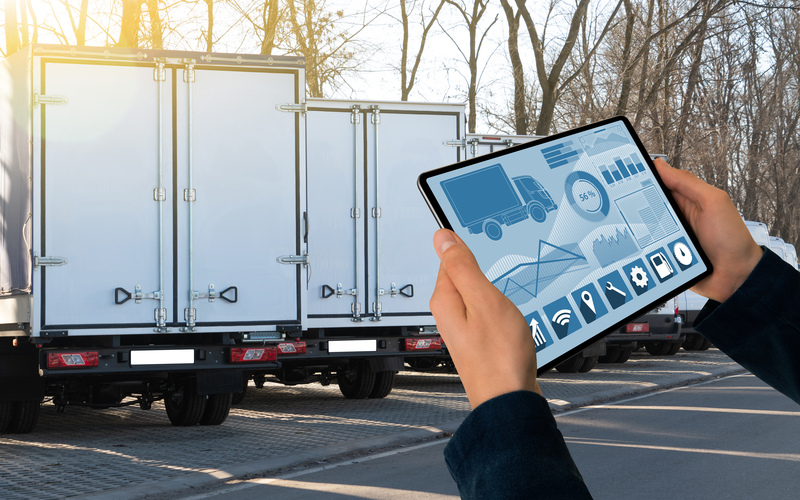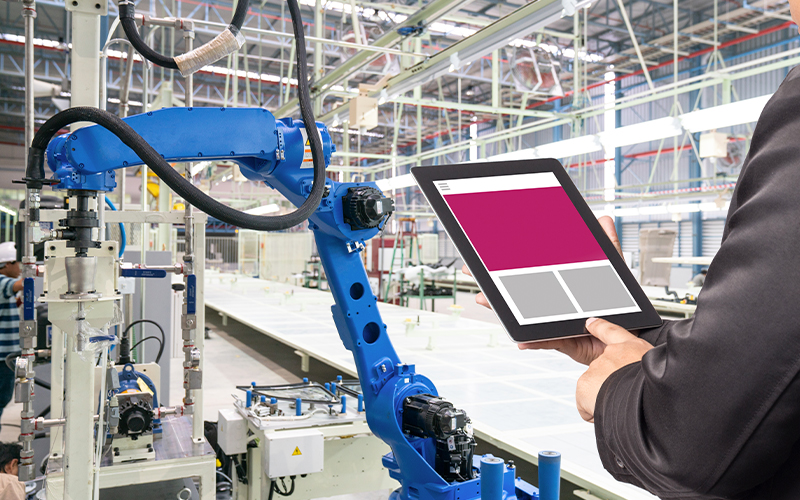Sourcing and Procurement
IoT in Mining
Introduction – Internet of Things in Mining
The Internet of things (IoT) is the extension of Internet connectivity into physical devices and everyday objects. Embedded with electronics, Internet connectivity, and other forms of hardware; these devices can communicate and interact with others over the Internet, and they can be remotely monitored and controlled. In the mining industry, IoT is used as a means of achieving cost and productivity optimization, improving safety measures and developing their artificial intelligence needs.
IoT in the Mining Industry
Considering the numerous incentives it brings, many large mining companies are planning and evaluating ways to start their digital journey and digitalization in mining industry to manage day-to-day mining operations. For instance:
- Cost optimization & improved productivity through the implementation of sensors on mining equipment and systems that monitor the equipment and its performance. Mining companies are using these large chunks of data – 'big data' to discover more cost-efficient ways of running operations and also reduce overall operational downtime.
- Ensure the safety of people and equipment by monitoring ventilation and toxicity levels inside underground mines with the help of IoT on a real-time basis. It enables faster and more efficient evacuations or safety drills.
- Moving from preventive to predictive maintenance
- Improved and fast-decision making The mining industry faces emergencies almost every hour with a high degree of unpredictability. IoT helps in balancing situations and in making the right decisions in situations where several aspects will be active at the same time to shift everyday operations to algorithms.
IoT & Artificial Intelligence (AI) application in Mining industry
Another benefit of IoT in the mining industry is its role as the underlying system facilitating the use of Artificial Intelligence (AI). From exploration to processing and transportation, AI enhances the power of IoT solutions as a means of streamlining operations, reducing costs, and improving safety within the mining industry.
Using vast amounts of data inputs, such as drilling reports and geological surveys, AI and machine learning can make predictions and provide recommendations on exploration, resulting in a more efficient process with higher-yield results.
AI-powered predictive models also enable mining companies to improve their metals processing methods through more accurate and less environmentally damaging techniques. AI can be used for the automation of trucks and drills, which offers significant cost and safety benefits.
Flowchart of IoT in Mining
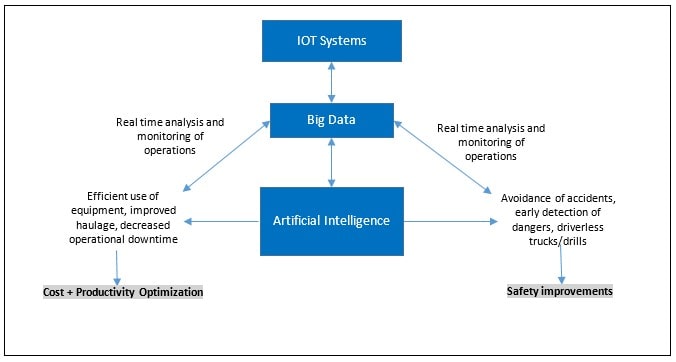
Below are some of the instances of IoT in the mining industry:
| Mining Company Name | Technology Partner | Time line | Description | Benefits |
|---|---|---|---|---|
| Rio Tinto - Koodaideri iron ore project - Australia | Multiple | 2019 initiated | Rio Tinto's Kookaideri project in Australia is set to build the world's first "intelligent mine" where all assets are networked together and are capable of making decisions in microseconds. The mine planned to deliver the first tonnes of ore in 2021. | Through real-time data, operators at the mine will be able to quickly test scenarios to optimize production or operations. |
| Hecla Mining Company -Casa Berardi mine - Canada | Newtrax | 2018 implemented | The mine introduced Newtrax's Mobile Equipment Telemetry in order to better manage machine downtime. With real-time equipment diagnostics, Hecla has been able to use data to determine optimal ways to utilize machines and make immediate diagnoses of equipment issues in order to decrease downtime. | Since its implementation, the mine has quantified an increase of an hour per day of operations. |
| Hindustan Zinc’s Sindesar Khurd (SK) mine - India | Newtrax | 2018 implemented | Newtrax MET integrated with the Sandvik OptiMine digital platform to track and receive data from the entire underground operation including drills, loaders, trucks and other equipment. | This project was implemented in order to improve overall efficiency. |
| Goldcorp - Porcupine Gold Mine's Borden site - Canada | Cisco | 2018 implemented | With a Ventilation on Demand system, Goldcorp can automatically adjust underground ventilation by controlling fans remotely through a centralized digital interface on the surface. This allows for a more efficient use of energy and can better control for potential operational stoppages due to a lack of ventilation. This kind of targeted ventilation has allowed the company to reduce the amount of air they pump into the mine from 1,200,000 cubic feet per minute (cfm) to 650,000 cfm. | This project has cut the operation’s electrical consumption in half and significantly reduced cost. |
| Glencore's Matagami Zinc mine - Canada | Newtrax | 2016 implemented | Newtrax's Mobile Equipment Telemetry provides mine operations with essential data from interconnected assets and equipment. Glencore has been able to better understand how their equipment works in order to improve productivity. | The company has reported that average tonnage of ore hauled in each trip has risen from 55 to 60 tonnes. |
Challenges for IoT in Mining
Although there are benefits of IoT in the mining industry, implementation of IoT in mining operations has faced many challenges in the past.
- Limited or unreliable connectivity especially in underground mine sites
- Remote locations may struggle to pick up 3G/4G signals
- Declining ore grade has increased the requirements to dig deeper in many mines, which may increase hindrances in the rollout of IoT systems
Mining companies have overcome the challenge of connectivity by implementing more reliable connectivity methods and data-processing strategies to collect, transfer and present mission critical data for analysis. Satellite communications can play a critical role in transferring data back to control centers to provide a complete picture of mission critical metrics. Mining companies worked with trusted IoT satellite connectivity specialists such as ‘Inmarsat’ and their partner eco-systems to ensure they extracted and analyzed their data effectively.
Cybersecurity will be another major challenge for IoT-powered mines over the coming years
As mining operations become more connected, they will also become more vulnerable to hacking, which will require additional investment into security systems.Following a data breach at Goldcorp in 2016, that disproved the previous industry mentality that miners are not typically targets, 10 mining companies established the Mining and Metals Information Sharing and Analysis Centre (MM-ISAC) to share cyber threats among peers in April 2017.
In March 2019, one of the largest aluminum producers in the world, Norsk Hydro, suffered an extensive cyber-attack, which led to the company isolating all plants and operations as well as switching to manual operations and procedures. Several of its plants suffered temporary production stoppages as a result. Mining companies have realized the importance of digital security and are investing in new security technologies.
Digitalization of Mining Industry - Road Ahead
Many mining companies have realized the benefits of digitalization in their mines and have taken steps to implement them. There are four themes that are expected to be central to the digitalization of the mining industry over the next decade are listed below:
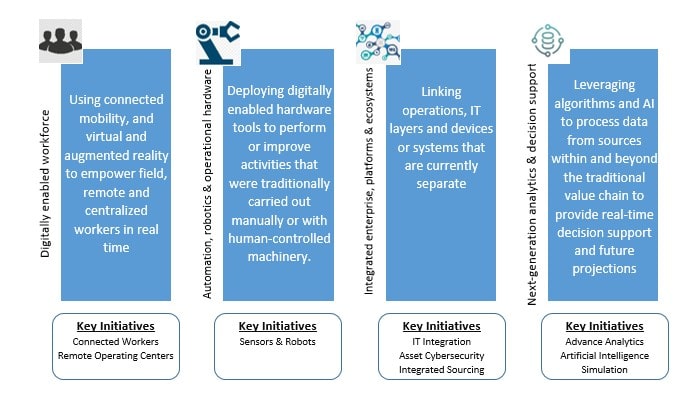
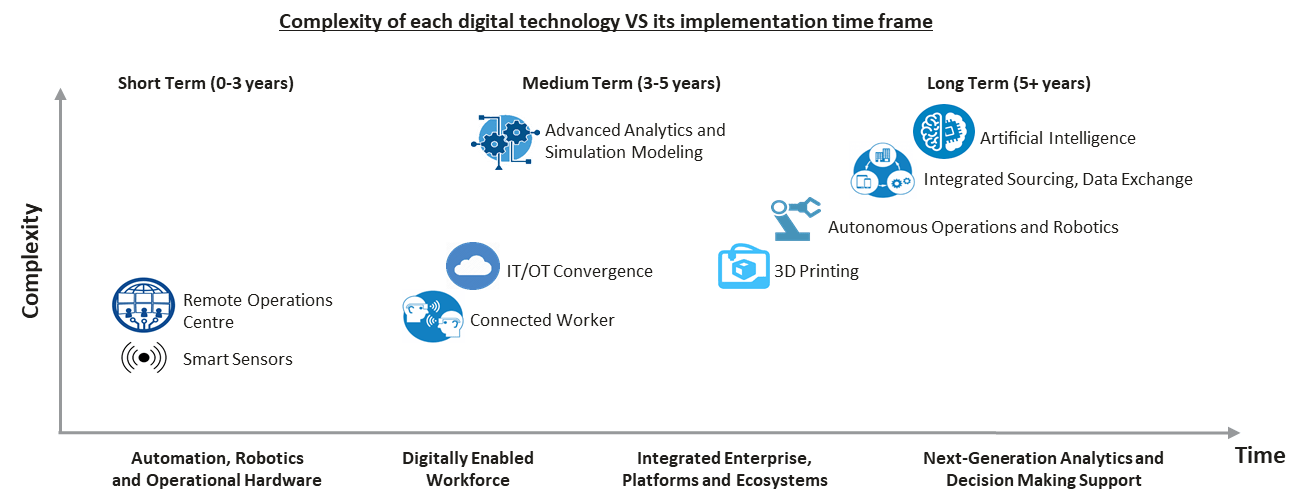
The above graph demonstrates the complexity of each digital technology and its implementation period for the widespread adoption of that technology. There are various factors, such as the complexity and scalability of the technologies involved in the adoption rate for specific technologies and for the overall digital transformation of the mining industry.
The world can expect to witness prominent developments from the mining industry to make it more sustainable. There are some unfavorable impacts of mining on communities, ecosystems, and other surroundings as well. With the intention to minimize them, the power of data is being harnessed through different IoT statements. Overall, IoT helps the mining industry shift towards resource extraction, keeping in mind a particular time frame and footprint that is essential.


